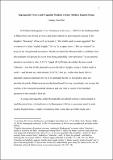| dc.contributor.author | Reid, Lindsay Ann | |
| dc.date.accessioned | 2020-02-25T15:08:36Z | |
| dc.date.available | 2020-02-25T15:08:36Z | |
| dc.date.issued | 2019 | |
| dc.identifier.citation | Lindsay Ann Reid (2019) 'Impregnable Towers and Pregnable Maidens in Early Modern English Drama'. Comparative Drama, 53 (1-2):85-109. | en_IE |
| dc.identifier.issn | 0010-4078 | |
| dc.identifier.uri | http://hdl.handle.net/10379/15804 | |
| dc.description.abstract | A young, marriageable, and implicitly pregnable woman s imprisonment in a purportedly impregnable tower (usually somewhere in Italy) is a recurrent motif in early modern English drama. Pertinent examples can be found in William Shakespeare s Two Gentlemen of Verona, Thomas Heywood s Golden Age, John Fletcher s Women Pleas d, James Shirley s Bird in a Cage, and Alexander Brome s Cunning Lovers. Attuned to the intertheatricality underpinning this set of embowered maiden plays, this article examines how architectural spaces of enforced gender segregation were repeatedly rendered insecure on the early modern English stage: people, objects, and stories were habitually depicted slipping in and out. Exhibiting a metaliterary self-awareness of their theatrical analogues as well as their relationships with non-dramatic textual traditions, these plays reiteratively highlight the inefficacy of the towers in which women have been immured to restrict their access to the wider sexual economy. Despite their commissioners intentions, such towers are never simply microcosmic worlds unto themselves, hermetically sealed from commerce with beyond. Rather, they are uniformly portrayed as permeable spaces that can accommodate or even generate movement and interaction between the world within and the world without. What is more, these maiden-containing towers of early modern dramatic tradition are decidedly hypertextual. As this article ultimately argues, Shirley s play, in particular, develops the fallible tower at its center as a recursive site of aestheticized mimesis and literary polysemy an inherently violable structure (itself seemingly pregnant with the weight of endlessly proliferating stories) that blurs apparent binaries not only between outside and inside, but also between art and life. | en_IE |
| dc.format | application/pdf | en_IE |
| dc.language.iso | en | en_IE |
| dc.publisher | Western Michigan University, Department of English | en_IE |
| dc.relation.ispartof | Comparative Drama | en |
| dc.rights | Attribution-NonCommercial-NoDerivs 3.0 Ireland | |
| dc.rights.uri | https://creativecommons.org/licenses/by-nc-nd/3.0/ie/ | |
| dc.subject | James Shirley | en_IE |
| dc.subject | early modern drama | en_IE |
| dc.subject | Caroline drama | en_IE |
| dc.subject | William Shakespeare | en_IE |
| dc.subject | Alexander Brome | en_IE |
| dc.subject | Thomas Heywood | en_IE |
| dc.subject | John Fletcher | en_IE |
| dc.subject | The Two Gentlemen of Verona | en_IE |
| dc.subject | The Cunning Lovers | en_IE |
| dc.subject | The Golden Age | en_IE |
| dc.subject | Women Pleased | en_IE |
| dc.subject | intertheatricality | en_IE |
| dc.title | Impregnable towers and pregnable maidens in early modern english drama | en_IE |
| dc.type | Article | en_IE |
| dc.date.updated | 2020-02-24T18:58:20Z | |
| dc.local.publishedsource | https://scholarworks.wmich.edu/compdr/ | en_IE |
| dc.description.peer-reviewed | peer-reviewed | |
| dc.internal.rssid | 14276069 | |
| dc.local.contact | Lindsay Ann Reid, English, College Of Arts,Social Science, And Celtic Studies, Nui Galway. Email: lindsay.reid@nuigalway.ie | |
| dc.local.copyrightchecked | Yes | |
| dc.local.version | ACCEPTED | |
| nui.item.downloads | 358 | |


